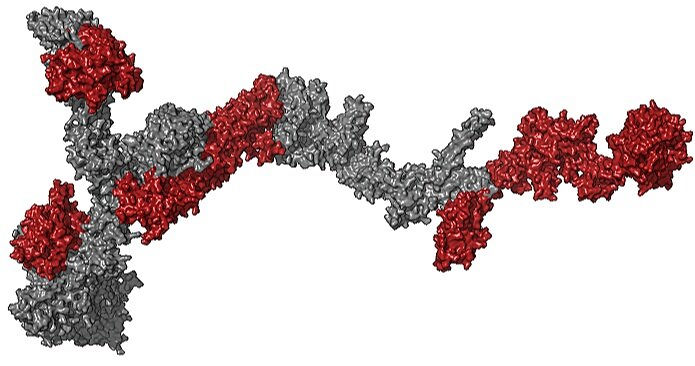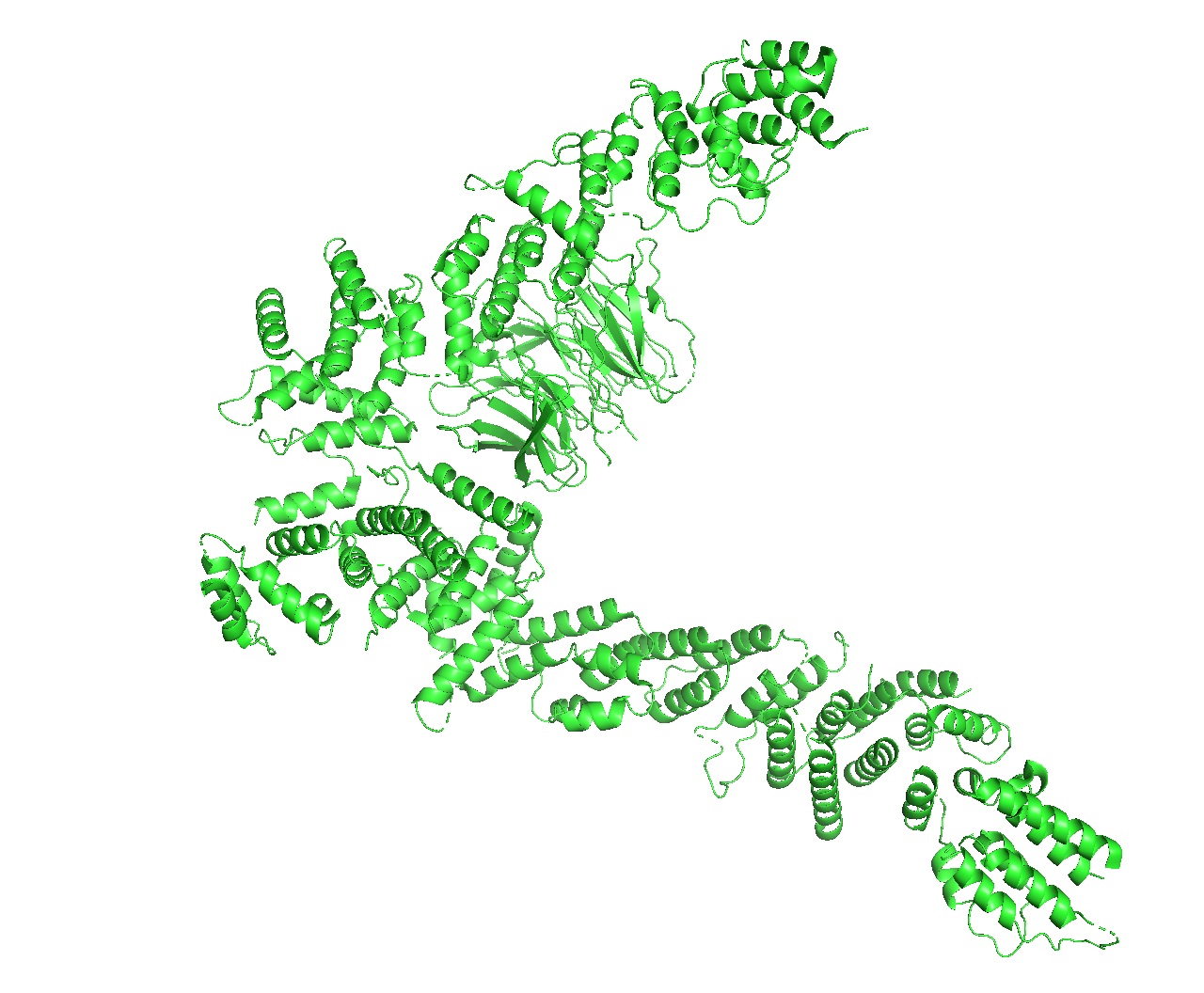
2024
Liran Fu, Erika Weiskopf, Onno Akkermans, et al. HIV-1 capsids enter the FG phase of nuclear pores like a transport receptor. Nature (2024). doi.org/10.1038/s41586-023-06966-w
2022
Thomas Schwartz. Solving the nuclear pore puzzle. Science (2022). doi: 10.1126/science.abq4792
Charles Swofford, Sarah Nordeen, et al. Structure and specificity of an anti-chloramphenicol single domain antibody for detection of amphenicol residues. Protein Science (2022). doi: 10.1002/pro.4457
Ranjan Singh et al. Nanobodies as allosteric modulators of Parkinson’s disease-associated LRRK2. PNAS (2022). doi: 10.1073/pnas.211271211
2021
Schuller, A.P., Wojtynek, M., Mankus, D., Tatli M., Kronenberg-Tenga, R., Regmi S.G., Dip P.V., Lytton-Jean A.K.R., Brignole E.J., Dasso M., Weis K., Medalia O., Schwartz T.U. The cellular environment shapes the nuclear pore complex architecture. Nature (2021). doi: 10.1038/s41586-021-03985-3
Lim SM, Cruz VE, Antoku S, Gundersen GG, Schwartz TU. Structures of FHOD1-Nesprin1/2 complexes reveal alternate binding modes for the FH3 domain of formins. Structure (2021). doi: 10.1016/j.str.2020.12.013
2020
Cheloha RW, Harmand TJ, Wijne C, Schwartz TU, Ploegh HL. (2020) Exploring cellular biochemistry with nanobodies. J Biol Chem. doi: 10.1074/jbc.REV120.012960.
Nordeen SA, Turman DL, Schwartz TU. (2020) Yeast Nup84-Nup133 complex structure details flexibility and reveals conservation of the membrane anchoring ALPS motif. Nat Commun. doi.org/10.1038/s41467-020-19885-5.
Nordeen SA, Andersen KR, Knockenhauer KE, Ingram JR, Ploegh H, Schwartz TU. (2020) A nanobody suite for yeast scaffold nucleoporins provides details of the nuclear pore complex structure. Nat Commun. doi.org/10.1038/s41467-020-19884-6
Cruz VE, Demircioglu FE, Schwartz TU. (2020) Structural Analysis of Different LINC Complexes Reveals Distinct Binding Modes. J Mol Biol. doi.org/10.1016/j.jmb.2020.09.019
Sonn-Segev A, Belacic K, Bodrug T, Young G, VanderLinden RT, Schulman BA, Schimpf J, Friedrich T, Dip PV, Schwartz TU, Bauer B, Peters JM, Struwe WB, Benesch JLP, Brown NG, Haselbach D, Kukura P. (2020) Quantifying the heterogeneity of macromolecular machines by mass photometry. Nat Commun. doi.org/10.1038/s41467-020-15642-w
2019
Demircioglu FE, Zheng W, McQuown AJ, Maier NK, Watson N, Cheeseman IM, Denic V, Egelman EH, Schwartz TU. (2019) The AAA+ ATPase TorsinA polymerizes into hollow helical tubes with 8.5 subunits per turn. Nat Commun. doi: 10.1038/s41467-019-11194-w
2018
Cruz VE, Schwartz TU. (2018) Recombinant Purification of the Periplasmic Portion of the LINC Complex. Methods in Mol Bio. doi: 10.1007/978-1-4939-8691-0_2.
2017
Onischenko E, Tang JH*, Andersen KR*, Knockenhauer KE, Vallotton P, Derrer CP, Kralt A, Mugler CF, Chan LY, Schwartz TU, Weis K. (2017) Natively Unfolded FG Repeats Stabilize the Structure of the Nuclear Pore Complex. Cell. doi: 10.1016/j.cell.2017.09.033
Hanke L, Schmidt FI, Knockenhauer KE, Morin B, Whelan SP, Schwartz TU, Ploegh HL. (2017) Vesicular stomatitis virus N protein-specific single-domain antibody fragments inhibit replication. EMBO Rep. doi: 10.15252/embr.201643764
2016
Hanke L, Knockenhauer KE, Brewer RC, van Diest E, Schmidt FI, Schwartz TU, Ploegh HL. (2016) The Antiviral Mechanism of an Influenza A Virus Nucleoprotein-Specific Single-Domain Antibody Fragment. mBio. doi: 10.1128/mBio.01569-16
Lawrence KS, Tapley EC, Cruz VE, Li Q, Aung K, Hart KC, Schwartz TU, Starr DA, Engebrecht J. (2016) LINC complexes promote homologous recombination in part through inhibition of nonhomologous end joining. J Cell Biol. doi: 10.1083/jcb.201604112
Saxton RA, Knockenhauer KE, Schwartz TU, Sabatini DM. (2016) The apo-structure of the leucine sensor Sestrin2 is still elusive. Sci Signal. doi: 10.1126/scisignal.aah4497
Demircioglu FE, Sosa BA, Ingram J, Ploegh HL, Schwartz TU. (2016) Structures of TorsinA and its disease-mutant complexed with an activator reveal the molecular basis for primary dystonia. eLife. doi: 10.7554/eLife.17983
Saxton RA, Chantranupong L, Knockenhauer KE, Schwartz TU, Sabatini DM. (2016) Mechanism of arginine sensing by CASTOR1 upstream of mTORC1. Nature. doi: 10.1038/nature19079
Apelt L, Knockenhauer KE, Leksa NC, Benlasfer N, Schwartz TU, Stelzl U. (2016) Systematic protein-protein interaction analysis reveals inter-subcomplex contacts in the nuclear pore complex. Mol Cell Proteomics. doi: 10.1074/mcp.M115.054627
Truttmann MC, Cruz VE, Guo X, Engert C, Schwartz TU, Ploegh HL. (2016) The Caenorhabditis elegans Protein FIC-1 Is an AMPylase That Covalently Modifies Heat-Shock 70 Family Proteins, Translation Elongation Factors and Histones. PLoS Genet. doi:10.1371/journal.pgen.1006023
Schwartz TU. (2016) The Structure Inventory of the Nuclear Pore Complex. J Mol Biol. doi:10.1016/j.jmb.2016.03.015.
Knockenhauer KE & Schwartz TU. (2016) The Nuclear Pore Complex as a Flexible and Dynamic Gate. Cell. doi: 10.1016/j.cell.2016.01.034
Demircioglu FE, Cruz VE, Schwartz TU. (2016) Purification and Structural Analysis of SUN and KASH Domain Proteins. Methods in Enzymology. doi:10.1016/bs.mie.2015.08.011
Saxton RA, Knockenhauer KE, Wolfson RL, Chantranupong L, Pacold ME, Wang T, Schwartz TU, Sabatini DM. (2016) Structural basis for leucine sensing by the Sestrin2-mTORC1 pathway. Science. doi:10.1126/science.aad2087
2015
Berchowitz LE, Kabachinski G, Walker MR, Carlile TM, Gilbert WV, Schwartz TU, Amon A. (2015) Regulated Formation of an Amyloid-like Translational Repressor Governs Gametogenesis. Cell. doi: 10.1016/j.cell.2015.08.060.
Ingram JR*, Knockenhauer KE*, Markus BM*, Mandelbaum J, Ramek A, Shan Y, Shaw DE, Schwartz TU, Ploegh HL, Lourido S. (2015) Allosteric activation of apicomplexan calcium-dependent protein kinases. Proc Natl Acad Sci USA. doi:10.1073/pnas.1505914112.
Knockenhauer KE & Schwartz TU. (2015) Structural Characterization of Bardet-Biedl Syndrome 9 Protein (BBS9). J Biol Chem. doi: 10.1074/jbc.M115.649202.
Kabachinski, G. & Schwartz, T.U. (2015). The nuclear pore complex – structure and function at a glance. J. Cell. Sci., 128, 423-429. doi:10.1242/jcs.083246.
Kelley K*, Knockenhauer KE*, Kabachinski G, Schwartz TU. (2015) Atomic Structure of the Y complex of the nuclear pore. Nat Struct Mol Biol., 22, 425-31 doi: 10.1038/nsmb.2998.
2014
Sosa, B.A., Demircioglu, E., Chen, J.Z., Ingram, J., Ploegh, H.L. & Schwartz, T.U. (2014). How lamina-associated polypeptide 1 (LAP1) activates Torsin. eLife doi:10.7554/eLife.03239.
Schwartz, T.U. (2014). Finding the missing link. eLife doi:10.7554/eLife.03128.
Ulrich A, Partridge JR, Schwartz TU. (2014). The stoichiometry of the nucleoporin 62 subcomplex of the nuclear pore in solution. Mol Biol Cell., 25, 1484-92. doi: 10.1091/mbc.E13-12-0745.
2013
Andersen KR, Leksa NC, Schwartz TU. (2013). Optimized E. coli expression strain LOBSTR eliminates common contaminants from His-tag purification. Proteins., 81, 1857-61. doi: 10.1002/prot.24364.
Andersen KR, Onischenko E, Tang JH, Kumar P, Chen JZ, Ulrich A, Liphardt JT, Weis K, Schwartz TU. (2013). Scaffold nucleoporins Nup188 and Nup192 share structural and functional properties with nuclear transport receptors. eLife. 2:e00745. doi: 10.7554/eLife.00745.
Sosa BA, Kutay U, Schwartz TU. (2013). Structural insights into LINC complexes. Curr Opin Struct Biol., 23, 285-91. doi: 10.1016/j.sbi.2013.03.005.
Bilokapic S, Schwartz TU. (2013). Structural and functional studies of the 252 kDa nucleoporin ELYS reveal distinct roles for its three tethered domains. Structure. 21, 572-80, doi: 10.1016/j.str.2013.02.006.
Rothballer A, Schwartz TU, Kutay U. (2013). LINCing complex functions at the nuclear envelope: what the molecular architecture of the LINC complex can reveal about its function. Nucleus., 4, 29-36. doi: 10.4161/nucl.23387.
2012
Ulrich A, Andersen KR, Schwartz TU. (2012) Exponential megapriming PCR (EMP) cloning--seamless DNA insertion into any target plasmid without sequence constraints. PLoS One. 2012, 7:e53360. doi: 10.1371/journal.pone.0053360.
Bilokapic, S. & Schwartz, T.U. (2012). Molecular basis for Nup37 and ELY5/ELYS recruitment to the nuclear pore complex. Proc. Natl. Acad. Sci., 109, 15241-15246. doi: 10.1073/pnas.1205151109
Sosa, B.A., Rothballer, A., Kutay, U. & Schwartz, T.U. (2012). LINC complexes form by binding of three KASH peptides to domain interfaces of trimeric SUN proteins. Cell, 149, 1035-1047. doi: 10.1016/j.cell.2012.03.046.
Bilokapic S, Schwartz TU. (2012). 3D ultrastructure of the nuclear pore complex. Curr Opin Cell Biol., 24, 86-91. doi: 10.1016/j.ceb.2011.12.011.
2011
Feng S, Li H, Zhao J, Pervushin K, Lowenhaupt K, Schwartz TU, Dröge P. (2011). Alternate rRNA secondary structures as regulators of translation. Nat Struct Mol Biol., 18, 169-76. doi: 10.1038/nsmb.1962.
2010
Leksa NC, Schwartz TU. (2010). Membrane-coating lattice scaffolds in the nuclear pore and vesicle coats: commonalities, differences, challenges. Nucleus., 1, 314-8. doi: 10.4161/nucl.1.4.11798.
Whittle JR, Schwartz TU. (2010). Structure of the Sec13-Sec16 edge element, a template for assembly of the COPII vesicle coat. J Cell Biol., 190, 347-61. doi: 10.1083/jcb.201003092.
Pandya RK*, Partridge JR*, Love KR, Schwartz TU, Ploegh HL. (2010). A structural element within the HUWE1 HECT domain modulates self-ubiquitination and substrate ubiquitination activities. J Biol Chem., 285, 5664-73. doi: 10.1074/jbc.M109.051805.
2009
Brohawn, S.G. & Schwartz, T.U. (2009). Molecular architecture of the Nup84–Nup145C–Sec13 edge element in the nuclear pore complex lattice. Nat. Struct. Mol. Biol., 11, 1173-1177. doi: 10.1038/nsmb.1713.
Brohawn, S.G., Partridge, J.R., Whittle, J.R. & Schwartz, T.U. (2009). The nuclear pore complex has entered the atomic age. Structure, 17, 1156-1168. doi: 10.1016/j.str.2009.07.014.
Whittle JR, Schwartz TU. (2009). Architectural nucleoporins Nup157/170 and Nup133 are structurally related and descend from a second ancestral element. J Biol Chem. 284, 28442-52. doi: 10.1074/jbc.M109.023580.
Brohawn SG, Schwartz TU. (2009). A lattice model of the nuclear pore complex. Commun Integr Biol., 2, 205-7. doi: 10.4161/cib.2.3.7873
Leksa NC, Brohawn SG, Schwartz TU. (2009). The structure of the scaffold nucleoporin Nup120 reveals a new and unexpected domain architecture. Structure. 17, 1082-91. doi: 10.1016/j.str.2009.06.003.
Partridge JR, Schwartz TU. (2009) Crystallographic and biochemical analysis of the Ran-binding zinc finger domain. J Mol Biol. 391, 375-89. doi: 10.1016/j.jmb.2009.06.011.
2008
Brohawn, S.G., Leksa, N.C., Spear, E.D. Rajashankar, K.R. & Schwartz, T.U. (2008). Structural Evidence for Common Ancestry of the Nuclear Pore Complex and Vesicle Coats. Science, 322, 1369-1373. doi: 10.1126/science.1165886.
Boehmer T, Jeudy S, Berke IC, Schwartz TU. (2008). Structural and functional studies of Nup107/Nup133 interaction and its implications for the architecture of the nuclear pore complex. Mol Cell. 30, 721-31. doi: 10.1016/j.molcel.2008.04.022.
2007
Schwartz TU. (2007) Origins and evolution of cotranslational transport to the ER. Adv Exp Med Biol. 607, 52-60. Review.
Jeudy S, Schwartz TU. (2007). Crystal structure of nucleoporin Nic96 reveals a novel, intricate helical domain architecture. J Biol Chem. 282, 34904-12. doi: 10.1074/jbc.M705479200
Boehmer T, Schwartz TU. (2007). Purification, crystallization and preliminary X-ray analysis of a Nup107-Nup133 heterodimeric nucleoporin complex. Acta Crystallogr Sect F Struct Biol Cryst Commun. 63, 816-8. doi: 10.1107/S1744309107040523
Drin G, Casella JF, Gautier R, Boehmer T, Schwartz TU, Antonny B. (2007). A general amphipathic alpha-helical motif for sensing membrane curvature. Nat Struct Mol Biol. 14, 138-46. doi: 10.1038/nsmb1194
2006
Kastenholz MA, Schwartz TU, Hünenberger PH. (2006). The transition between the B and Z conformations of DNA investigated by targeted molecular dynamics simulations with explicit solvation. Biophys J. 91, 2976-90. doi: 10.1529/biophysj.106.083667
Schwartz TU, Schmidt D, Brohawn SG, Blobel G. (2006). Homodimerization of the G protein SRbeta in the nucleotide-free state involves proline cis/trans isomerization in the switch II region. Proc Natl Acad Sci U S A. 103, 6823-8. doi: 10.1073/pnas.0602083103
2005
Schwartz TU. (2005). Modularity within the architecture of the nuclear pore complex. Curr Opin Struct Biol. 15, 221-6. doi:10.1016/j.sbi.2005.03.003
2004
Berke IC, Boehmer T, Blobel G, Schwartz TU. (2004). Structural and functional analysis of Nup133 domains reveals modular building blocks of the nuclear pore complex. J Cell Biol. 167, 591-7. doi: 10.1083/jcb.200408109
Schwartz TU, Walczak R, Blobel G. (2004). Circular permutation as a tool to reduce surface entropy triggers crystallization of the signal recognition particle receptor beta subunit. Protein Sci. 13, 2814-8. doi: 10.1110/ps.04917504


































